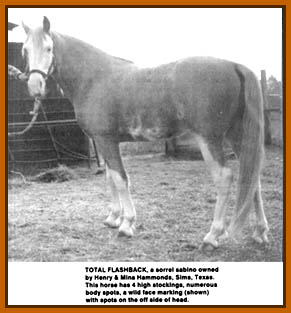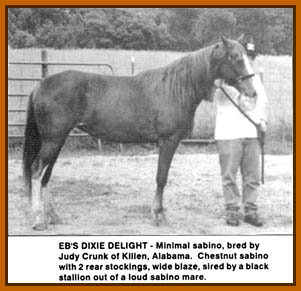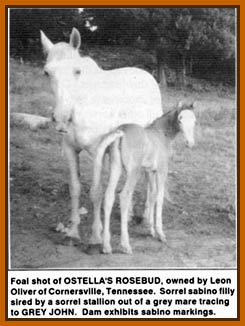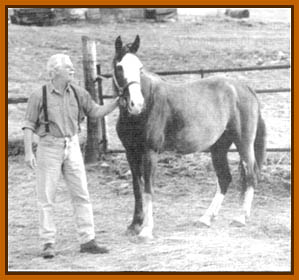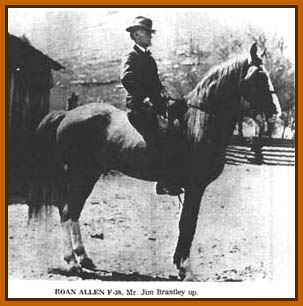| ABOUT US |
| OUR STALLION |
| OUR MARES |
| OUR FOALS |
| FOR SALE |
| JUST SAY SABINO |
| GROOMING TIPS |
| PHOTOGRAPHY TIPS |
| CONFORMATION INFO |
| BROODMARE INFO |
| POETRY |
| LINKS |
| BANNERS |
|
|
|
|
Firefly Walkers. We let the Walkin do the Talkin. JUST
SAY SABINO! |
|
|
(As taken from the July Plantation Showcase with permission by Darlene Krauss and author Franne Brandon)
|
|
|
|
|
|
|
|
|
Jet flight, space travel, microchips, the Internet, heart bypasses, shots for chicken pox! Science has taken rapid strides forward in the past sixty years. Animal sciences have also noted considerable progress, especially in the areas of disease prevention and control. The ubiquitous Coggins test was unknown even thirty years ago. One area of equine research that once lagged behind has now come to the forefront because of the economic impact coat color serves in determining the market value of horses. This new genetic research demands an end to the differences in nomenclature once accepted by various breed associations. On page 36, Vol.1 of the first TWHBEA Register published, nine color choices are listed for horses eligible for the new registry. These were: sorrel, chestnut, black, roan (red, strawberry, chestnut and blue), white, bay, brown, grey, and yellow. The yellow category did not distinguish the color of the mane and tail. Bowing to the will of science, the TWHBEA now divides golden-diluted horses into two major groups, distinguished by the presence or absence of pink skin and amber eyes. Since these two groups breed quite distinctly, this change reflects the impact of the most recent coat color research, as well as the observations of astute breeders across the nation.
However, palominos and buckskins, along with pink-skinned
champagnes, are in the minority in terms of Tennessee Walker
coat color when compared to other distinct groups that have
predominated since before the registry’s formation.
The golden-coated walkers are a result of the dilution of
the basic coat color with another gene.
Other variations of basic sorrel, chestnut, bay and black
result from genetic packages termed patterns. Patterns add white to the base color. A number of patterns occur among registered Tennessee Walkers. Grey and tobiano have distinct listings on the application for registration. The other two are lumped together as roan, a term used for decades. Recent research indicates, though, that two different genetic patterns are represented, producing distinguishable phenotypes, (outward appearances), and more seriously, possible reproductive problems if two individuals bearing the same roan genetic pattern are mated together. The true roan, as accepted by most American as well as European breed associations, is a horse with an even distribution of white hairs in the base coat. The evenness of the white hairs in the pattern often results in a horse with a very silver body that, in the black version, is sometimes mistaken for grey. The white hairs are not present on the head or lower legs, or in the mane and tail, which always appear darker than the body. White markings, if present, are very conservative. Roan is a dominant genetic pattern that is always heterozygous because: if two roans mated together produce a homozygous embryo, the foal dies in-utero. The most famous roan line in Tennessee Walker Horses is probably that founded by GO BOY’S SOUVENIER, whose roan dam “V” was sired by the roan stallion, JOE RUTHERFORD, whose dam was a roan mare with no markings, MC WHORTERS NELL X-1120, later accorded registration #441702.
Among Tennessee Walkers is a second pattern of white
hairs mixed in the base coat.
This pattern is rare among other breeds, with the
exception of the British Clydesdale.
The second pattern does not produce an even silvering of
the base coat. The
white pattern may be sprinkled in one place on the coat,
yet concentrated at another to produce small, medium-sized, or
large body spots. Spots
can also occur on the face and lower legs, not just the body.
The markings are as erratic as the roaning.
Stockings are generally high, often running up past the
knee and hock joints. Faces
generally sport a wide blaze at minimum; more often are bald.
Sometimes the markings on the head and neck, or the hocks
and rump, merge to create eye-arresting body spots that intrigue
by the very uniqueness of their patterns.
Other individuals carry rather unobtrusive belly spots
that are less noticeable. Still
other horses with the gene for this pattern show only the
evidence of two or more high stockings, a wide blaze, and a few
white hairs in the base coat.
This pattern, more common than the roan pattern among
Tennessee Walkers, has several names.
Two of the more common are
“calico roan” and “sabino”. The sabino pattern is not a pattern of roaning at all, but a spotting pattern, along with tobiano and overo. Unlike the roan with its absolute heterozygosity, the sabino occurs in a homozygous form. The maximally expressed sabino is a white horse with the solid color, if expressed, generally on the top of the head and ears. Theoretically, such a white horse would always produce a sabino offspring when crossed with a solid-colored horse, or at least a foal capable of transmitting the sabino pattern to its offspring. From the horses designated as foundation sires and dams of the TWHBEA Register, twelve are listed as roan. One prominent older bloodline is represented by the stallion given the foundation number F-25. EARNHART’S BROOKS F-25 is described as a “roan horse, four stocking, and spot on belly, bald”. This BROOKS stallion was a classic spotted sabino. A more popular foundation stallion, ROAN ALLEN F-28, bred by James Brantley, is described as “a roan horse, both hind stockings, fore socks, strip”. ROAN ALLEN F-38 was not a roan at all, but a minimally expressed sabino. The son retained as ROAN ALLEN’S replacement as head sire on the Brantley farm, BRANTLEY’S ROAN ALLEN, JR. #350066, is described as a “roan horse, four stockings, spot on shoulder and side, bald”. Perhaps the influence of the third dam, a daughter of EARNHEART’S BROOKS, contributed to the extensive spotting pattern that BRANTLEY’S ROAN ALLEN, JR. carried. When crossed with the foundation mare SALLIE F-45, who was sired by ROAN ALLEN F-38, BRANTLEY’S ROAN ALLEN, JR. sired the solid white mare LILLIE WHITE #350074, the first World Champion Aged Mare crowned at the 1939 Celebration. The sabino’s were the first spotted Tennessee Walking Horses common among the original plantation walkers whose genes contributed to the pool of stock accepted into the infant TWHBEA Registry in 1935. Before a few tobiano’s received registration certificates as the registry began, sabino’s were creating excitement under saddle, in harness, and behind the plow. In the 1935 Register, thirteen percent of the horses registered were spotted sabino’s, with even more of the non-spotted or white sabino’s accorded registration numbers. The Tennessee Walking Horse breed features a genetic pattern that is rare in the equine world but common in the breed’s history. The sabino pattern should be given the recognition that other patterns representing a smaller percentage of the breed now claim. If you are an owner of sabino's, with a sabino foal to register, or breed for this pattern as a preference, it is up to you to voice your opinion, if you wish this distinction to be on your foal’s registrations. Should dozens of breeder insist that their pattern receive the same recognition as rarer colors, their voices will be heard! Write a note or letter accompanying the foal’s application for registration, send a copy of the pattern description from a genetics book or article, and insist that your foal is not a roan and should not be incorrectly registered as such. Be firm in your insistence and just say “SABINO!” Note: TWHBEA now recognizes the pattern of sabino. Franne Brandon stated in an email to me (Vicky Stenmo) on 1-29-01 that sabino is “now considered to be a polygenic trait, meaning it comes out better if the solid-colored parent has sabino in the background, sports stockings itself, etc. Also, some solid horses appear to be dominant to sabino, but would not be to tobiano, a dilute gene, etc.” Franne also describes the term "heathered roaning" as: "Heathered roaning" is what I call the effect of the roan hairs mixed in the sabino coat. It mutes, or lightens, the value of the base color. The Spanish word sabino means "a lighter shade of red." In contrast, the roan hairs of the true roan create a very silver effect that is sometimes confused with gray."
|
|
|
|
|
|
|
|
|
|
|
|
|
|
|

